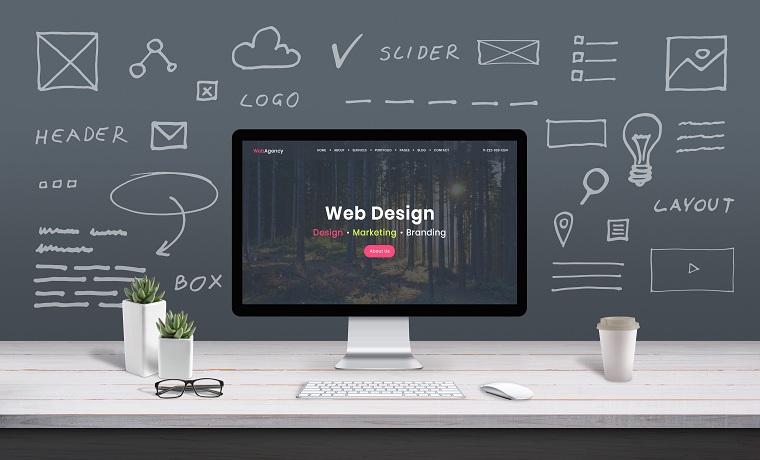A website’s overall aesthetic is an integral part of the web development process. Attractive and intuitive websites help businesses drive more web traffic, translating into increased sales and brand awareness over time. This is the reason why a career in web design is in demand.
Web design specialists like December Labs are people who have a keen eye for design. Besides possessing prowess in applying design principles, web designers are skilled in crafting website frameworks, designing UX and UI, and coding.

Begin With A Simple Project
Working on a project you are interested in can make the learning process of web design more fun.
As a beginner, it could be a bit overwhelming to start a journey without knowing where your destination is. Yes, you want to be a web designer, but that in itself is pretty vague. Set a specific goal to work on a simple project first. Beginning with the end in mind helps you organize the steps you need to take to get to where you want to be.
Start with a simple project. Complex websites like social media or eCommerce websites might be too tricky if you’re just starting out. An excellent place to start applying what you’re learning would be designing blogs or landing pages. Try out different design trends, like minimalism, maximalism, etc.
Stay Updated With Design Trends
Web design and development is continuously evolving year after year. And because it’s in-demand, a career in web design could be highly competitive. As a neophyte in the industry, you need to stay up-to-date with present and emerging trends to work your way across the playing field.
Knowing the trends in your trade also builds your credibility as a designer. Instead of offering basic services, you are more equipped to provide clients with innovative design solutions. It might sound like something you should not bother about, but you can miss so much if you are not up to date regarding what is trendy and why is that trendy when it comes to web design.
Create A Design Swipe File
A swipe file is a collection of writing samples, like articles, ad copies, headlines, etc. Writers use this to gain insight and inspiration when writer’s block occurs.
Starting out your journey as a web designer isn’t easy. Sometimes, you’ll experience roadblocks where your mind is constipated from coming up with ideas.
Curating your own design swipe file can help you when you feel stuck and clueless about taking on a project.
Learn The Language
When you start working as a web designer, clients will not only look for your ability to design a web page in your credentials. In most cases, they’ll also look into your programming background. For most designers, this might be the most challenging part: learning computer languages.
However, knowing how to code doesn’t mean you need to learn how to create sophisticated software programs. You just need to grasp the essential concepts of front-end languages, like HTML, CSS, and JavaScript, and apply them to your designs. Your coding skills will help you translate the design you created into a deployable website on the world wide web.
Understand User interface (UI) and User experience (UX) Design Concepts
Although most people use UI and UX designs interchangeably, each design concept has a significant difference from one another.
User Interface design refers to the look and feel of your website. It is the process of designing the aesthetics of a website. Every button, color palette, typography, animation, and interactivity of your website is related to UI.
On the other hand, user experience design deals with how a user would feel when they visit a website. In UX design, you must improve the ease of experience of your website. You’ll know how useful the user experience is when visitors enjoy visiting your website.
Use Design Principles In Web Design
Designing a website is no different than, say, crafting an attractive poster. As you prepare a website that wows clients, consider applying basic design principles like layout, color, and typography. The colors and fonts you’ll use on your website convey your branding. In choosing a typeface, make sure to prioritize readability more than aesthetics. Choose a color palette that’s straightforward and that blends together harmoniously.
Prepare Content
Food for thought (literally): when preparing a meal, is it better to keep cramming to the pantry to get all the ingredients or lay all the ingredients on the kitchen counter? You’d agree to the latter, correct?
The same principle can be applied when designing a website. Prepare all the logos, images, articles, and placeholders, so you can have a better overview of what your design looks like. Don’t get stressed thinking about every possible content you need; just focus on the basics, and you’re good to go.
Learn How To Create Frameworks
Your website’s overall layout is like a skeleton where all your content muscles, feature organs, and aesthetic skin hangs. Focusing on your website’s structure gives you a better overview of where your design and content should go.
Staring at a blank text editor can be a bit mind-blocking at times. This is why creating a website framework first can help you visualize what the website should look like. Familiarize yourself with computer programs like Adobe Photoshop, Illustrator, InDesign, and Dreamweaver that can help you design a framework without breaking any sweat.
Start Working On Your First Project
Now that you’ve done the necessary preparations, it’s time to fire up your computer and start designing your first masterpiece.
Learning the basics beforehand is essential, but that’s only the tip of the iceberg. Web designing becomes more exciting when you start cutting your teeth in applying all the design concepts, principles, and coding languages into one working web masterpiece.
As you’re starting out, don’t get discouraged if some concepts or pieces of code does not make sense at first. Keep trying. As with other things, becoming a master in web designing requires hours of practice and thousands of trials and errors.
Obtain Feedback
The moment of truth in any design process is putting your work out in the open. That might be a terrifying experience since receiving criticism for your hard work is possible. Take those comments with a grain of salt and focus on constructive feedback. Use those as inspiration to become better at what you do. Over time, applying those feedbacks to your work can help you become a better designer.
Conclusion
Designing websites is undoubtedly a fun and high paying career. You get to create interactive websites as you continuously learn the emerging trends in web design. As a beginner, you need to hone your skills in applying the basics of design and programming. This will eventually land you a spot in the playing field of web designers.

